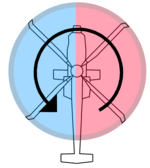
| |
| retreating blade side | advancing blade side |
Dissymmetry of lift[1]: 2–20 [2] (also known as asymmetry of lift[3]: 342 [4] or asymmetric lift[5][6]) in rotorcraft aerodynamics refers to an unequal amount of lift on opposite sides of the rotor disc. It is a phenomenon that affects single-rotor helicopters and autogyros in forward flight.
A rotor blade that is moving in the same direction as the aircraft is called the advancing blade and the blade moving in the opposite direction is called the retreating blade. When viewed from above, most American helicopter rotors turn counter-clockwise; French and Russian helicopters turn clockwise.[3]: 141
Balancing lift across the rotor disc is important to a helicopter's stability. The amount of lift generated by an airfoil is proportional to the square of its airspeed (velocity). In a hover, the rotor blades have equal airspeeds and therefore equal lift. However, in forward flight the advancing blade has a higher airspeed than the retreating blade, creating uneven lift across the rotor disc.[7][8]: 1–104
- ^ "2. Aerodynamics of Flight". Helicopter Flying Handbook (PDF). Federal Aviation Administration. 2012. Retrieved 17 January 2022.
- ^ Croucher, Phil (2007). Professional Helicopter Pilot Studies. Lulu.com. p. 2-21. ISBN 9780978026905. Retrieved 18 January 2022.
- ^ a b Watkinson, John (2004). Art of the helicopter. Oxford: Elsevier Butterworth-Heinemann. ISBN 9780080472034.
- ^ Keith-Lucas, D (29 May 1958). "Vertical take-off aircraft: some problems of design". New Scientist.
- ^ Leishman, J. Gordon (2006). Principles of helicopter aerodynamics (2nd ed.). Cambridge: Cambridge University Press. p. 699. ISBN 9780521858601.
- ^ NASA Authorization for Fiscal Year 1967: Hearings, Eighty-ninth Congress, Second Session, on S. 2909. United States Congress Senate Committee on Aeronautical and Space Sciences. 1966. p. 485.
- ^ Helicopter Flying Handbook (FAA-H-8083-21A ed.). FAA. 2012. pp. 2-18–2-19.
- ^ "1". Fundamentals of Flight FM 3-04.203 (PDF). US Department of the Army. May 2007.